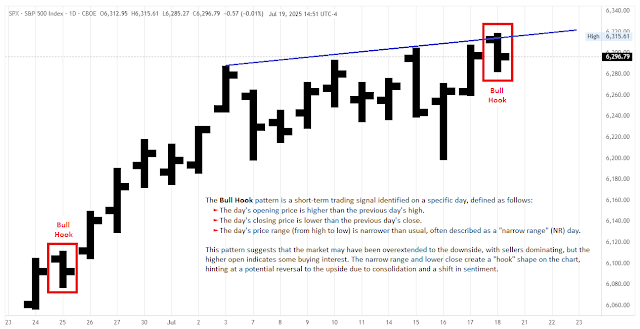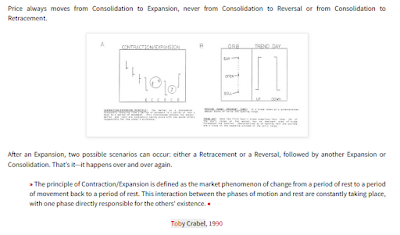Markets
typically shift from small ranges to larger trend moves. When the
market is in a large trend move, wait for it to settle into smaller
ranges before getting involved. This gives more reliable setups when the
market trends again. Market tops generally occur when the price closes
well off its low, while market bottoms happen when the price closes near
its low. Most traders get emotional during these times, buying at tops
and selling at bottoms. Once you understand this, it becomes easier to
make smarter trades.
Small Ranges Beget Large Ranges. Large Ranges Beget Small Ranges.
Markets
move from congestion to creation (expansion), transitioning from small
ranges to larger, more defined trend moves. A small range signals
buildup, and a large range signals an impending trend. If I see a small
net change from open to close, I know a large trend move is likely
coming and am prepared to act on it. Here’s
an example using the NASDAQ: Notice how volume
fluctuates throughout the day: heavy volume in the morning, a dip in the
middle, and a surge towards the end.
"U" shaped intraday: Heavy volume in the morning, a dip in the middle, a surge at the end.
This
pattern is consistent across markets. It’s like a freeway: traffic is
heavy in the morning, dies down in the middle of the day, and picks up
in the afternoon. Understanding this helps day traders identify
opportunities in the morning and towards the end of the day, while
avoiding the midday lull. Volume drives range, and large ranges happen
at the start and end of the day. This is when short-term traders make
money. We need volatility and large ranges to profit.
There are three key cycles in market behavior:
(1) small range/large range, (2) moving closes within ranges, and (3) closes opposite openings.
All three cycles work equally well in any timeframe and market.
"Do yourself a big favor: Mark off all the large-range days [in the chart above], and then study the size of the ranges just
prior to explosive up-and-down days. See what I see? We are given ample warning of virtually every large-range day
by the shrinkage of ranges a few days earlier."
The
key takeaway for short-term traders is that not every day offers a
high-probability trade. You need to identify days with potential for
explosive moves and not expect large profits daily. It’s about finding
that opportunity.
As
for market tops, they usually occur when prices close near their highs,
and bottoms happen when prices close near their lows. Focus on these
closing patterns to determine when to buy and sell.
Trend is a function of time. The more time in a trade, the more opportunity for trend.
The
most important insight in trading is that trends are the basis of all
profits. Without a trend, there are no profits. But what causes trends?
Trends are fundamentally a function of time—the more time you hold a
trade, the more opportunity for a trend to develop. The challenge with
day trading is that trends occur only about 15% of the time. Most of the
time, prices are consolidating, making it difficult to catch a big
trend move. Limiting yourself to a few hours of trading only targets
that small window when trends are likely to occur.
My Day Trade Secret: HTTC - Hold To The Close.
The
day trader dilemma is that they have limited time to catch trends.
Holding positions overnight allows you to capture longer trends and
larger profits. A small bet with the potential for a big move is the key
advantage of holding positions over time.
» How you know a large trend move is coming. «
Many day traders are afraid
to hold positions overnight. However, if you do the math, you'll see
that most market moves happen between the close of one day and the open
of the next. Moves within the day are often smaller and less reliable.
For short-term traders, the key to success is recognizing large range
days and holding positions to the close. This is how you catch a big
move during the day.
» Hold To The Close. «
S&P 500 E-mini Futures (daily bars).
Narrow Range 4 & 7 Days and Inside Bar Narrow Range 4 & 7 Days.
Narrow Range 4 & 7 Days and Inside Bar Narrow Range 4 & 7 Days.
See also:














+-+January11,+2016%20conv%2012.png)

+-+January11,+2016%20conv%2013.png)




+-+January11,+2016%20conv%2015.png)
+-+January11,+2016%20conv%2014.png)

+-+January11,+2016%20conv%2016.png)
+-+January11,+2016%20conv%2017.png)









